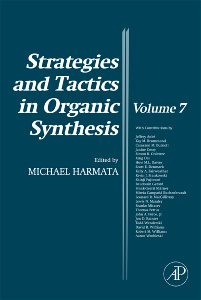Description
Strategies and Tactics in Organic Synthesis
Strategies and Tactics in Organic Synthesis Series
Coordinator: Harmata Michael
Language: English
Subjects for Strategies and Tactics in Organic Synthesis:
536 p. · 15x22.8 cm · Hardback
Description
/li>Contents
/li>Readership
/li>Biography
/li>Comment
/li>
chapter 2 A FORMAL TOTAL SYNTHESIS OF THE MARINE
DITERPENOID, DIISOCYANOADOCIANE
chapter 3 TOTAL SYNTHESES OF ZOAPATANOL
chapter 4 SYNTHESIS OF MOLECULAR TWEEZERS AND
CLIPS BY THE USE OF A MOLECULAR LEGO SET AND THEIR SUPRAMOLECULAR FUNCTIONS
chapter 5 APPLICATION OF C-GLYCOSIDES IN THE TOTAL SYNTHESIS OF (-)-GAMBIEROL
chapter 6 A BIOMIMETIC APPROACH TO THE OCAGLAMIDES EMPLOYING PHOTOGENERATION OF OXIDOPYRYLIUMS
DERIVED FROM 3-HYDROXYFLAVONES
chapter 7 SYNTHESIS STUDIES OF DOLABELLANES AND TRANSANNULAR PROCESSES LEADING TO RELATED DITERPENES
chapter 8 DIPHENYLOXAZINONES: VERSATILE TEMPLATES
FOR THE ASYMMETRIC SYNTHESIS OF ??-AMINO ACIDS, PEPTIDE ISOSTERES, AND NATURAL PRODUCTS
chapter 9 RHODIUM-CATALYZED CYCLOISOMERIZATION
REACTIONS OF ALLENES IN DIVERSITY-ORIENTED
SYNTHESIS
chapter 10 HYDROGEN-BOND-MEDIATED ORGANIC SYNTHESIS IN THE SOLID STATE
chapter 11 TOTAL SYNTHESES OF NATURAL PRODUCTS
USING THE COMBINED C??H ACTIVATION/COPE REARRANGEMENT AS THE KEY STEP
chapter 12 THE TOTAL SYNTHESIS OF AMPHIBIAN
ALKALOIDS USING THE INTRAMOLECULAR SCHMIDT REACTION
chapter 13 SEDUCED BY A SIREN’S CALL: EXPANDING
APPLICATIONS FOR AROMATIC COMPOUNDS AND THE SYNTHESIS OF (+)-RISHIRILIDE B
In 1980, he began graduate studies in chemistry at the University of Illinois-Champaign/Urbana where he was awarded a University Teaching Fellowship. He worked with Professor Scott E. Denmark on the invention of the carbanion-accelerated Claisen rearrangement. In his second year of study, he was awarded an Eastman Kodak Research Fellowship.
Upon graduation in 1985, he was awarded an NIH postdoctoral fellowship which he used to study with Professor Paul A. Wender at Stanford University, where he worked on the synthesis of the neocarzinostatin chromophore.
In 1986, Prof. Harmata began his independent career at the University of Missouri-Columbia. He became an Associate Professor in 1992 and a full professor in 1998. In 2000, he was named the Norman Rabjohn Distinguished Professor of Chemistry in recognition of his achievements in research and teaching. In 1998, he received a research fellowship from the Alexander von Humboldt Foundation and stayed for a year at the University of Göttingen where he was affiliated with the groups of Professors Reinhard Brückner and Lutz. F. Tietze. In 2000, he served as chair of the Gordon conference on Organic Reactions and Processes. In 2010, he was named the first Justus Liebig Professor of Chemistry at the Justus Liebig Üniversität in Giessen, Germany. In 2011, he was a JSPS fellow. He has been a visiting professor in Giessen and Strasbourg and has delivered over 180 invited lectures in the United States and Europe. He is a member of the American Chemical Society, Gesellschaft Deutscher Chemiker, International Society of Heterocyclic Chemistry, and the Alexander von Humboldt Association of America.




